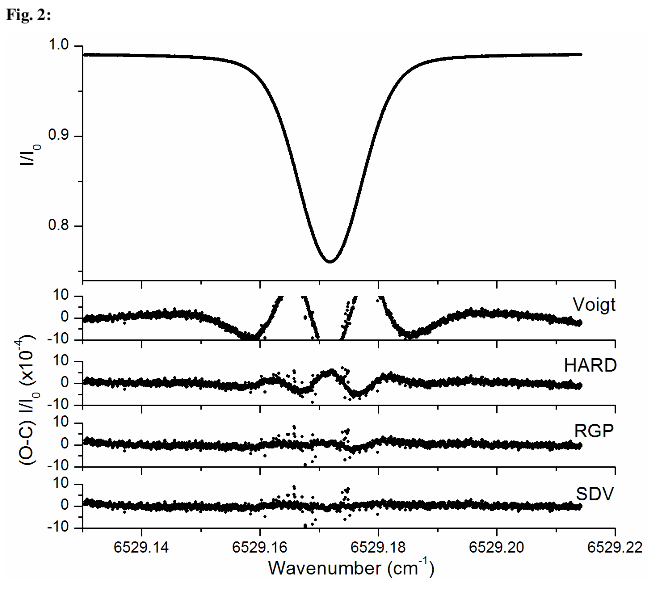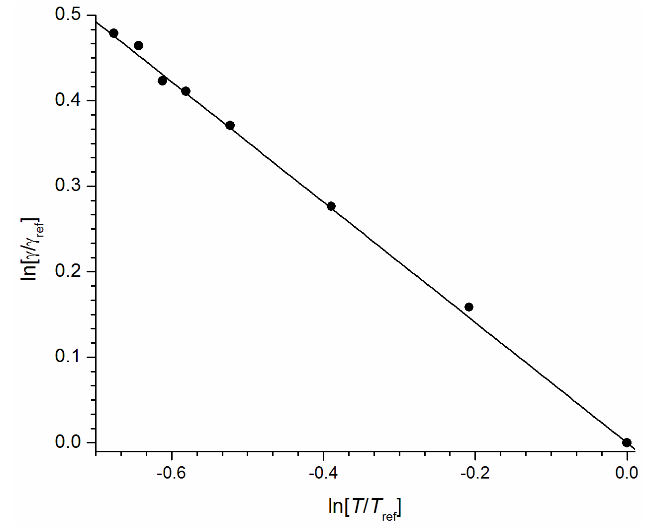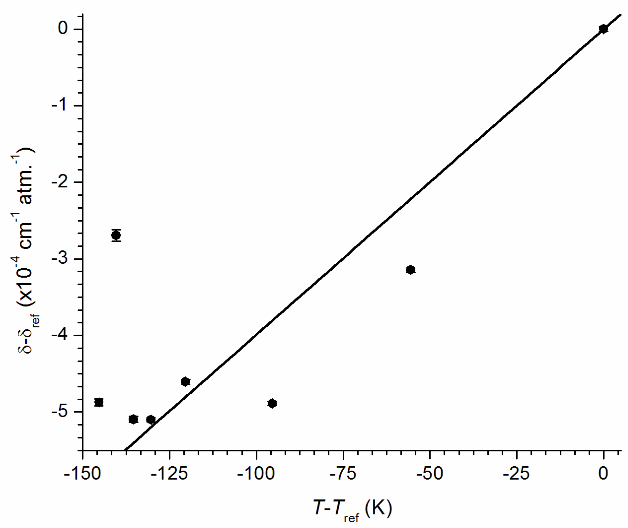www.acsprf.org
Reports: ND648876-ND6: Frequency-Based Optical Spectroscopy
Trevor J. Sears, PhD , State University of New York at Stony Brook
Using an extended cavity diode laser (ECDL) referenced to a femtosecond frequency comb, precision line shape measurements of single rotational lines of the v1 + v3 combination band of acetylene as a function of pressure, sample composition and temperature have been completed. Due to the extreme stability and accuracy of the comb source, these measurements are unique in their precision and range and provide unparalleled opportunities to test current state-of-the-art semi-empirical line shape models. Signal-to-noise ratios are of the order of 104. Figure 1 shows an example of the data quality. It is a scan through the, isolated, P(11) line at a pressure of 0.11 Torr at 299 K in a path length of 56.605 cm. Under these conditions, the line has a purely Gaussian profile depending on known parameters, which is demonstrated by results of a fit in the lower panel illustrating a signal-to-noise ration of approximately 10,000.
Figure 1: Doppler broadened P(11) line in the v1+v3 band of acetylene at 195739.6 GHz (6529.17 cm-1) recorded using an extended cavity diode laser referenced to a frequency comb. The results of a fit to the (known) lineshape are illustrated by the observed-calculated residuals in the lower panel. |
The instrument function can be determined in this way, and we found a maximum laser emission half-width at half-maximum (HWHM) of 250 kHz under the measurement conditions and this was fixed in all subsequent lineshape analyses.
Measurements of sample absorption at higher pressures results in lineshapes that are no longer simple Gaussian, but include collisional broadening due to collisions that, through various mechanisms, limit the lifetime of the absorbing state. Absorption by samples at pressures between approximately 100 and 760 Torr can often be characterized by Voigt or Lorentzian functions depending on a temperature-dependent lifetime broadening parameter Î≥s(T) for self-broadening or Î≥f(T) for broadening by collisions with a buffer (foreign) gas molecule. Pressure shifts, Î≥s(T); Î≥f(T), may also be added to these functions. Data were recorded between 296 and 150 K and sample pressures between 0.1 and 500 Torr for pure acetylene gas. Additional measurements of broadening by nitrogen have also been completed, and their analysis is underway. Accurate characterization of the pure gas absorption lineshapes is a necessary prerequisite for work on the foreign gas broadening. Figure 2 shows an example of a measurement of the same line recorded at a pressure of 4 Torr at 150 K and a pathlength of 1.085 cm.
| Figure 2: Transmission spectrum of the acetylene P(11) line at 4 Torr and 150 K in a 1.085 cm absorption path length. Bottom panels show the observed-calculated residuals resulting from fits to the measurement using the corresponding lineshape models. HARD=hard collision, RGP=Rautian-Galatry Profile and SDV=Speed-Dependent Voigt. |
At pressures below about 40 Torr, one may encounter narrowing of the absorption lines, with the Doppler component narrowing as the pressure increases. This is referred to as confinement or Dicke narrowing and characterized by a narrowing parameter Î2s(T) or Î2f(T). As pressure increases, this effect tends to increase, but becomes hidden by the much larger collisional broadening. Dicke narrowing is included in the mathematical formulation of the HARD and RGP models. Figure 2 illustrates the poor agreement of the popular Voigt profile approximation seen under many pressure and temperature conditions, while the increasingly more sophisticated HARD and RGP models are significantly more accurate but still show non-random residuals. The bottom panel in figure 2 shows the results of a fit to the speed-dependent Voigt (SDV) profile, representing a different physical and mathematical model. In this model, the broadening and shift are assumed to depend on the collisional speed, which varies across the line, and a simple, inverse power law, form for the inter-molecular potential energy surface.
We found that, of all those considered, only the SDV model was able to reproduce the observed data over its full range of temperature and pressure. In particular, no other model can reproduce the observed line asymmetry seen to be increasingly important at intermediate pressures and lower temperatures. This is an important result, because it tells us that commonly used lineshape functions assuming Hard or Soft velocity-changing collisions are not reliable, while the SDV, the simplest of many speed-dependent models, which is no more complicated, can reproduce all the measurements to the experimental measurement precision. The temperature dependence of the major parameters resulting from the SDV fits to the data are illustrated in Figure 3.
Figure 3: (left) A plot of the experimentally determined broadening parameters from the SDV model. The slope of the lne determines the temperature dependence exponent (n). (right) A plot of the difference between the experimentally determined shift at T and the value at 296 K (Tref). For both plots, measurement errors are mostly smaller than the symbols. |
The temperature dependence of the broadening coefficient, Î≥, is expected to follow an exponential form as Î≥(T)/Î≥(Tref) = (Tref/T)n and the results summarized in figure 3 show this is indeed the case. The temperature dependence of the shift is less well understood. There is a slight trend to larger magnitude shifts (actually more negative) with decreasing temperature. The data plotted in figure 3 (right hand panel) assumes a linear dependence. There are very few, if any, other measurements to compare to our data in this regard.
In summary, the results show that the SDV profile is the most suitable profile of those tested for describing the absorption lineshape for this band of acetylene at temperatures between 296K and 150K. The most commonly used lineshape models (i.e Voigt, Rautian and Galatry) do not include speed-dependent terms and do not account for the observed line asymmetries we have measured at low-moderate pressures and low temperatures. The precision of the fitted parameters are several orders of magnitude greater than any previously published for this (or any) band of acetylene. This precision derives from the extremely accurate frequency scale associated with the optical frequency comb used in these measurements.




